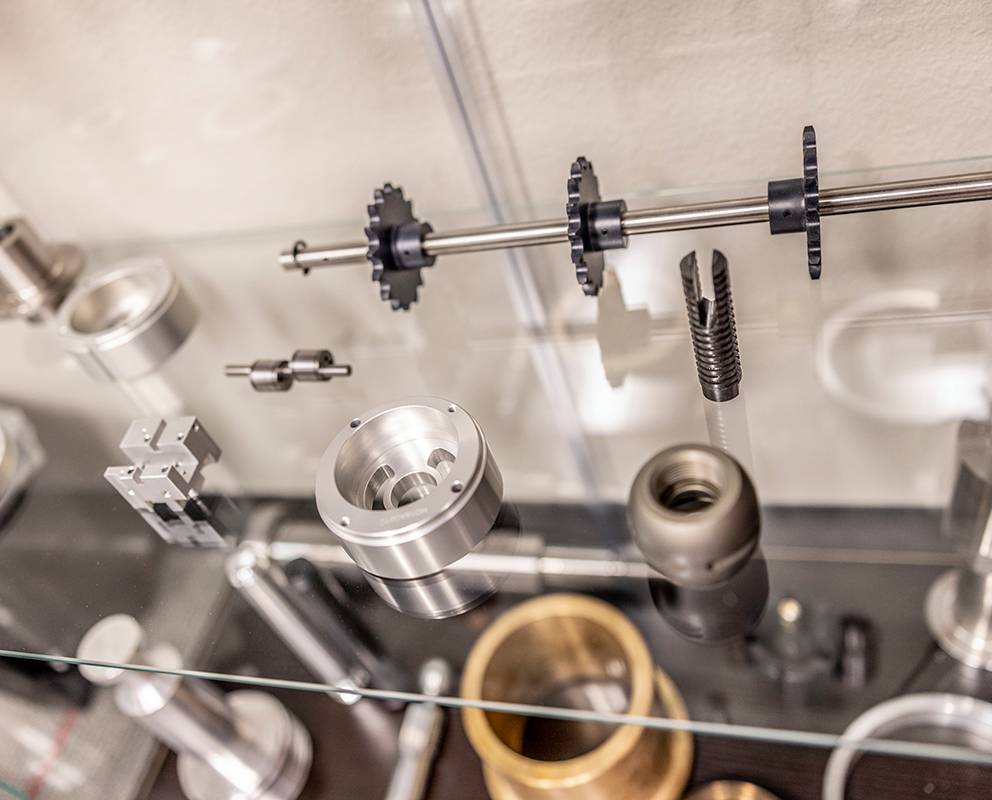CNC Swiss technology, also referred to as Swiss machining, is a precision manufacturing process used primarily for producing high-accuracy, small diameter and intricate parts. This technology lends itself to many different industries, but has multiple applications for machining medical devices, aerospace components, electronics, and automotive. It is particularly effective when applied to applications that require precision turning and milling of small (.010 -1.5″ Dia.) generating complex shapes.
History and Development
The origins of Swiss machining date back to the late 19th century in Switzerland, where it was initially developed for the watchmaking industry. Swiss watchmakers required an ultra-precise method of producing small parts for their timepieces. The technology evolved from mechanical cam-driven lathes. It has now transitioned into CNC (Computer Numerical Control) machining systems. Todays’ CNC Swiss machines combine traditional Swiss mechanical precision with the added flexibility of modern CNC controls. It adds versatility and efficiency to the machining process and can be used for both short and long term production.
How CNC Swiss Machines Work
A CNC Swiss machine is a type of turning center that uses a sliding headstock design to produce parts. This design enables the workpiece to move along the X, Y, and Z axes while the cutting tool remains stationary. In essence, the workpiece slides through the machine, and the tools are positioned to perform operations, such as turning, drilling, and milling, at various points along its length.
Key Components of CNC Swiss Machines:
- Sliding Headstock: The heart of Swiss-type lathes is the sliding headstock. This allows for precise movement and is especially useful for long, slender parts. The sliding headstock pushes the material forward as it is being machined, which minimizes material deflection and improves the surface finish.
- Guide Bushing: A distinguishing feature of Swiss lathes is the guide bushing, which provides support to the workpiece while it is being machined. The bushing holds the part in place as it moves, ensuring rigidity and stability during the cutting process. This feature is key to achieving high levels of precision, especially for smaller diameters.
- Live Tooling: CNC Swiss machines can be equipped with live tooling, which means that tools such as drills, taps, and mills can be rotated to perform secondary operations while the workpiece is being turned. This feature significantly reduces the need for secondary machining operations and allows for more complex geometries to be machined in a single setup.
- Multi-Axis Capability: Most modern CNC Swiss machines feature multi-axis capabilities, including C-axis and Y-axis movement. This enables the machine to perform a wide range of operations, such as drilling holes at various angles or performing back-turning and cross-drilling operations simultaneously.
- Automatic Tool Changer (ATC): Some CNC Swiss machines come equipped with an automatic tool changer, allowing the machine to switch between tools without manual intervention. This increases the automation of the process and reduces cycle time.
Benefits of CNC Swiss Technology
- High Precision: Swiss-type machines are renowned for their ability to produce highly accurate and intricate components with tight tolerances, often in the range of a few microns. The combination of a rigid machine structure, precise tool movement, and stable workholding ensures high-quality results.
- Enhanced Productivity: CNC Swiss machines can run unattended for long periods, especially with automated features such as bar feeders, automatic tool changers, and part catchers. This makes them highly efficient for high-volume production runs, particularly when small, complex parts need to be made in large quantities.
- Reduced Material Waste: Due to the sliding headstock design and precise tooling, Swiss machines are capable of working with very small and precise stock materials, which reduces material waste and contributes to cost efficiency in production.
- Complexity in Design: Swiss machines are capable of machining intricate parts with complex geometries. They can perform turning, drilling, milling, and threading operations simultaneously, allowing for parts that would otherwise require multiple setups on other types of machines to be completed in a single pass.
- Versatility: CNC Swiss machines are adaptable to a wide variety of materials, including metals like stainless steel, brass, aluminum, and titanium, as well as plastics and composites. This versatility makes them ideal for a range of industries, including medical, aerospace, automotive, and electronics.
Applications of CNC Swiss Technology
- Medical Devices: Precision is paramount in the medical industry. CNC Swiss technology is used to manufacture components for medical implants, surgical instruments, and diagnostic equipment. These parts often require tight tolerances and complex shapes.
- Aerospace: The aerospace industry demands components that are lightweight, durable, and able to withstand extreme conditions. CNC Swiss machines are used to produce turbine blades, fasteners, and other critical components where precision and reliability are crucial.
- Electronics: In the electronics industry, parts like connectors, switches, and housings are commonly manufactured using Swiss machining. The ability to work with small parts with high accuracy is ideal for electronic components that require fine details and complex geometries.
- Automotive: From engine components to fasteners, CNC Swiss technology is utilized in the automotive industry to create high-precision parts that contribute to the performance and safety of vehicles.
Conclusion
CNC Swiss technology offers unmatched precision and versatility, making it an invaluable tool for industries requiring high-quality, small parts with intricate geometries. With the combination of sliding headstock designs, guide bushings, multi-axis capabilities, and automated systems, CNC Swiss machines continue to be at the forefront of advanced manufacturing, driving innovation in sectors such as aerospace, medical, automotive, and electronics. Whether in high-volume production or small-batch runs, CNC Swiss technology provides the accuracy, speed, and flexibility needed to meet the demands of today’s complex manufacturing challenges.

